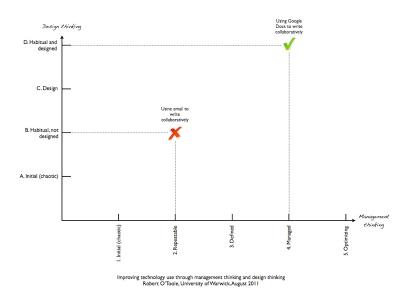A systematic and creative method
The "ecological" nature of the domain (learning and teaching) suggests that a scientific (or biological) approach is necessary. That is true to an extent. We need to get a clear understanding of habits and habitats, what they do and what they are capable of doing (and what impacts upon effectiveness and efficiency). But it is also subjective, in that diverse values, qualitative differences, are actively created (we hope). Innovation goes in two ways - optimising to a better solution, and discovering different problems and approaches. Sometimes we end up trying to optimise something that should just be abandoned. Other times we switch to a different design that can't easily be managed or optimised. The method that we have evolved from the Open-space Learning project aims to move in both of these potentially contradictory directions - managing, optimising and creating alternatives where necessary. It is both systematic and creative.
Bearing in mind that a learning ecology always spans well beyond the confines of a single class(room), especially considering how technologies that students use are more likely to be their own consumer electronics, improving the technological aspect of a learning ecology is necessarily a broader collaborative effort. For example, if good practice in live archiving with mobile phones is encouraged and practiced across the institution, it will work more effectively and unobtrusively within the OSL space. You will probably find that, to enhance the use of technology in your own teaching and learning, you will benefit from alliances and collaborative action more widely.
Here is our approach to doing so:
A. Implement a formal and systematic continual process for improving technology-enhanced learning and teaching practice. It should be evidence based, realistic, practical and participatory.
1. Undertake a survey to identify a baseline of IT and related skills and practices.
2. Identify key actions that might be good candidates for improvement (for example "improving performance through feedback"). This should be done continually through the academic year. For each key action, specify desirable and undesirable outcomes, and measures for assessing the effectiveness of existing and modified practice.
3. Periodically choose key actions to investigate (continually during the academic year, or before they are likely to appear in your own practice). Use observations, interviews and surveys to document the practices that are currently being used to undertake the action. Use OSL methods to create and test narratives that demonstrate the practices. Assess the effectiveness of the practices. Where already-successful practices and technologies are identified, use them as the basis for Objectives B and C below.
4. Assess whether the practices should be improved through more efficient, more manageable, optimised technologies and techniques, or if they could be replaced by alternative techniques and technologies. Consider where the practice sits on the diagram shown below.

Click the diagram to enlarge it to full size.
Use OSL techniques to design and test lo-fi prototypes (acting them out with props rather than the real thing) and hi-fi prototypes.
5. Create a proposal for change. Involve students. Investigate the feasibility of the proposed change, and the means by which it can be achieved. Also use this information to influence management policy and provisions for training and support. Use OSL methods to explore the relationships and roles that could make change possible, and the impact of change over time.
6. Where possible, form a project to implement the change and assess its impact. Involve students. They are essential.
7. Evaluate the impact of change, report and publicise to achieve wider adoption.
B. Collaboratively review existing and new technologies, considering how they might be used to improve technology-enhanced teaching and learning practice. Experiment with them. Use an OSL approach to create and test narratives about how they might be used.
C. Investigate existing good practice, identifying the specific conditions make it possible, how it might be impossible or difficult elsewhere, and what might need to be done to help it transfer. Use OSL techniques to create and test narratives about how they might be used. Create "showcase" articles and presentations, illustrating the benefits of the practice, and demonstrating how it can be adopted.
Open-space Learning methods can play a central role in the process of developing a learning ecology. They allow us to stage habits, imagine and act-out alternatives, free ourselves and come back down to earth. Next, we will look in detail at the role that OSL can play in such participatory design thinking...
